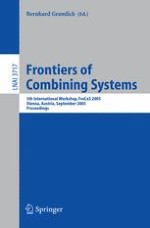2005 | Buch
Frontiers of Combining Systems
5th International Workshop, FroCoS 2005, Vienna, Austria, September 19-21, 2005. Proceedings
herausgegeben von: Bernhard Gramlich
Verlag: Springer Berlin Heidelberg
Buchreihe : Lecture Notes in Computer Science
